Webinar On OSHA COVID Changes

Next week, the Wisconsin Cheese Makers Association (WCMA) will host an exclusive webinar detailing newly-revised COVID-19 guidance for employers from the U.S. Occupational Safety and Health Administration (OSHA). The webinar, open only to WCMA members and offered at no cost, will be held on Tuesday, September 14 from 1:00-1:45 p.m. (CT).
“With COVID-19 infections and hospitalizations rising again, it’s critical to keep communication clear between regulators and employers,” said John Umhoefer, WCMA Executive Director. “WCMA is pleased to continue to support our members in their efforts to provide the safest possible work environments amid the continuing pandemic.”
This WCMA webinar will feature Wisconsin State Laboratory of Hygiene (WSLH) Industrial Hygiene Consultant-Engineer George Gruetzmacher, PhD, CIH, CSP, PE and Environmental Health Specialist Kelli Rush. The presentation will detail what dairy processors can expect if they are inspected by OSHA in relation to their COVID-19 protocols. Rush will also explain the free services offered to Wisconsin employers by the WSLH WisCon COVID-19 Consultations program.
WCMA will reserve time at the end of the webinar for responses to member questions on any COVID-19 related topic, with WCMA staff presenting pre-submitted questions anonymously. Association members should send their questions by 12 p.m. (CT) on Monday, September 13 to WCMA Senior Director of Programs & Policy Rebekah Sweeney.
For more information and to register now, visit WisCheeseMakers.org.
Archery, Crossbow Seasons Open Soon
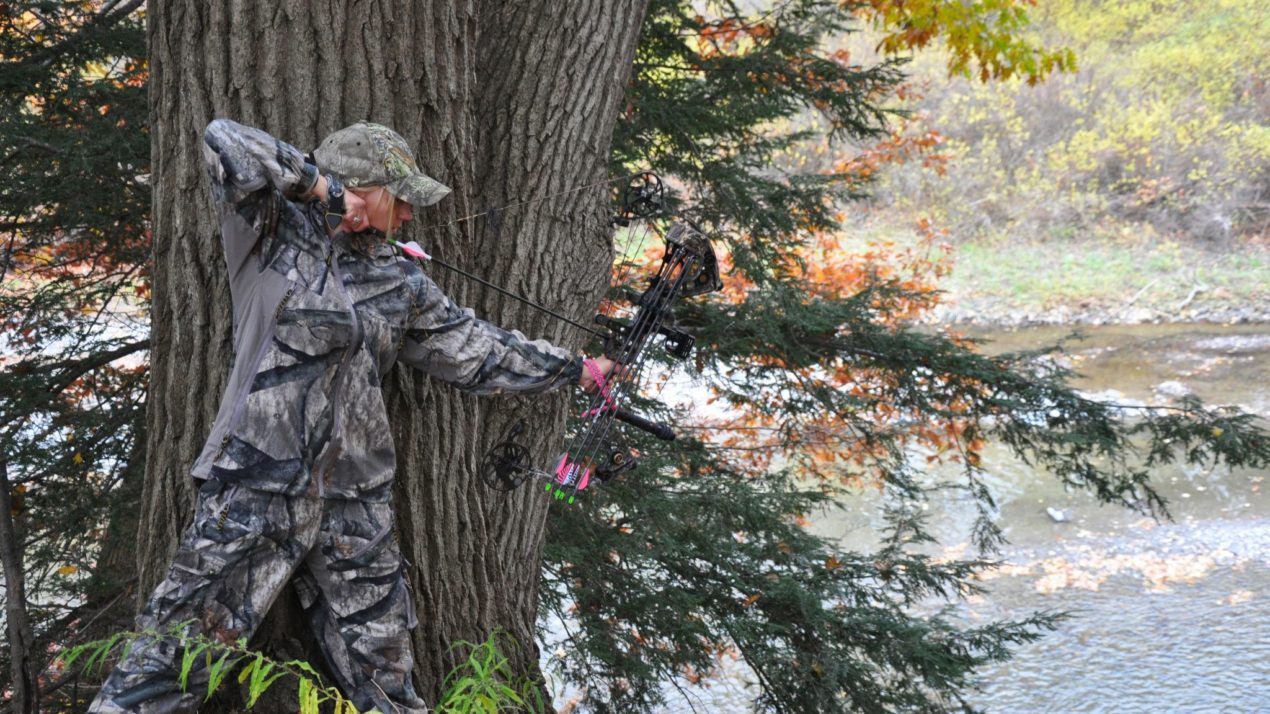
The Wisconsin Department of Natural Resources (DNR) is reminding hunters of their first opportunity to deer hunting this fall for the 2021 archery and crossbow deer season openers. These seasons run concurrently statewide from Sept. 18 to Jan. 9, 2022. The archery and crossbow seasons extend to Jan. 31, 2022, in 27 Farmland Zone Deer Management Units and all metro sub-units.
“We saw another mild winter last year, so Wisconsin deer hunters can look forward to increased harvest opportunities this season,” said Jeff Pritzl, DNR Deer Program Specialist. “Whether you’re hunting public or private land, I encourage hunters to get out and become familiar with seasonal food sources as this will influence deer movement in their local area.”
In 2020, archery and crossbow hunters harvested more than 110,000 deer, including more than 64,000 bucks, an increase from 2019.
Those interested in hunting with both a vertical bow and crossbow may do so by paying full price for one license and purchasing a $3 upgrade for the second license. Only one bow buck harvest authorization will be issued to hunters who purchase both licenses.
Hunter Safety And TAB-K
The DNR urges hunters to review these four rules of safety (TAB-K) before enjoying the archery and crossbow season.
- Treat every bow/crossbow as if it were loaded.
- Always point the bow/crossbow in a safe direction.
- Be certain of your target; what is before and beyond it.
- Keep your finger outside the trigger guard until ready to shoot.
Archery-Specific Safety Tips
When heading out to hunt during the archery or crossbow seasons, remember these additional safety tips:
- Crossbows have a safety. Immediately after cocking, always check to make sure that your bow is on safe.
- Always use bolts/arrows recommended by the manufacturer and handle carefully.
- Protect yourself and the arrow points with a covered arrow quiver.
- The safest way to carry, transport and raise or lower a crossbow from a stand is always to have the crossbow un-cocked.
- The safest way to un-cock a crossbow is to fire a bolt into the ground or target.
- Make sure that the limb tips are free of obstructions and your fingers, hand or arm are not in the string path at any time while the crossbow is cocked.
- Know your range for accuracy.
Tree stand safety is also a key consideration through all the deer hunting seasons. Tree stand incidents are a leading cause of injury to hunters. Always wear a safety harness, use three points of contact when going into or out of the stand and use a haul line to bring the unloaded bow or crossbow into the stand. Let someone know where you are going and when you expect to return. For more information regarding tree stand safety, visit the DNR webpage here.
Bonus Authorizations Still Available
Bonus antlerless harvest authorizations remain available in many counties. Bonus antlerless harvest authorizations may be filled using any weapon type during the appropriate season with the appropriate license but must be filled in the designated zone, unit and land type (public or private). Bonus antlerless harvest authorizations are available on a first-come, first-served basis at the cost of $12 each for residents, $20 each for non-residents and $5 for youth hunters under age 12.
In 2021, a Farmland (Zone 2) antlerless harvest authorization is included with each deer hunting license purchase in units that offer them. Some units will offer more than one antlerless deer harvest authorization with each deer license.
Hunters who have not yet purchased a deer hunting license will be prompted to select the county and land type for the Farmland (Zone 2) antlerless harvest authorizations at the time of purchase. Purchase a license online at GoWild.WI.Gov or at license sales locations.
Hunters who purchased their deer hunting licenses before June 1 may now select their Farmland (Zone 2) harvest authorizations. Hunters who have yet to determine a hunting location may defer the Farmland (Zone 2) antlerless harvest authorization selection. When ready, hunters may make a harvest authorization selection online from their Go Wild account to print themselves or visit an authorized license sales location to print, requiring a $2 processing fee.
GameReg
As a reminder, all harvested deer must be registered electronically by 5 p.m. the day after the deer is recovered. GameReg is simple, fast and convenient for hunters. As conservationists, hunters understand the importance of harvest registration and what it means to deer management in Wisconsin. The system will prompt hunters to answer a series of questions, beginning with the unique harvest authorization number and their date of birth.
Hunters have three options to register their deer:
- Online at GameReg.WI.Gov (fastest and easiest option);
- By phone at 1-844-426-3734 (1-844-GAME-REG); or
- Electronically at a participating in-person registration station (keyword “registration stations“).
More information regarding electronic registration is available by visiting the DNR webpage here.
Enroll In Dairy Goat Academy
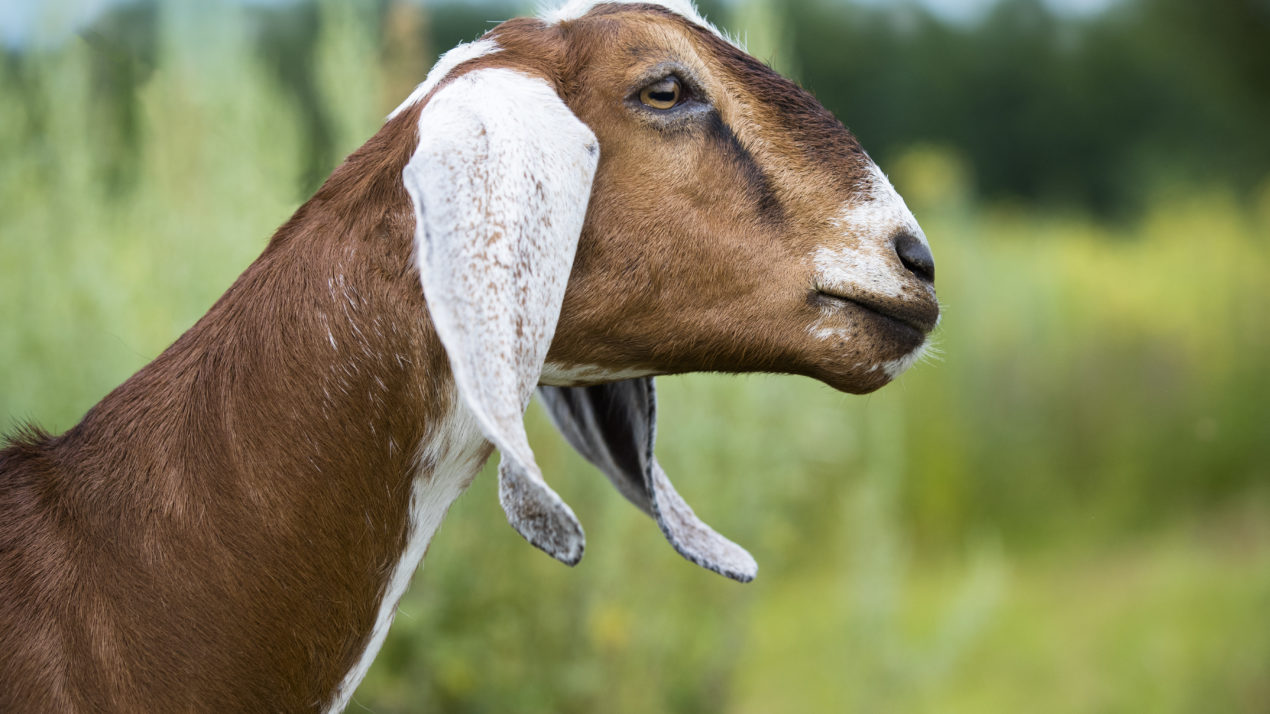
The 2021 Dairy Goat Academy is 2 weeks away! September 24 at Southwest Tech In Fennimore Wisconsin. This years event features a Premier Presenter Lineup for Meat and Dairy Goat Producers, as well as a vendors fair and producer networking! Enroll now!
DAIRY GOAT ACADEMY SCHEDULE
8:00 AM
Registration
9:00 AM
Welcome and Keynote Presentation: Chilton Dairy: Raising Goats in America’s Dairyland
10:00 AM
- Meat Goat Farm Tour Virtual tour of a commercial grain-free pastured meat goat herd- Cherrie Nolden,1dr Acres Farm
- Goat Milk Sweets, Learn how to make a variety of goat milk goodies! -Cindy Hoehne Rainbow Ridge Farm
- PR in AG, or, more accurately, “My Grandparents Didn’t Need a P.R. Person … Why Do I?” -Avi Stern, Director of Public Affairs for Milk Source LLC
11:00 AM
- Goat Procedures-Dr. Sally, Lancaster Veterinary Office
- Environmental sustainability of dairy goats – How do they compare to Dairy Cattle and other species- Dr Plummer
12:00 PM
Lunch – Vendor Introductions
1:00 PM
- Health Assessment and Necropsy in Meat Goats -Dr Sally, Lancaster Veterinary Office
- Nutrition and Kid care after weaning- Morgan Allen, Ruminant Nutritionist, Big Gain, Inc.
- Assuring dairy goat well-being using benchmarking and lameness monitoring-Dr. JK Shearer Professor and Extension Veterinarian- Iowa State, College of Veterinarian Medicine
2:00 PM
- The Business Of Goat Grazing-Aron Steele, Founder, Goats On The Go®
- Managing does during Transition-Morgan Allen, Ruminant Nutritionist, Big Gain, Inc.
- Abortions – Dr. Plummer, Iowa State College of Veterinarian Medicine
3:00 PM
- Meat Goats for Pasture, Profit, and Personal Growth- Aron Steele, Founder, Goats On The Go®
- Producer Panel-Michelle and Tad Ellinghuysen 2 Creeks Farm and Lacey Leona Jean Manager, Udder Alternative Dairy and Windy Prairie Goat Dairy and Anna Thompson Hajdik, Legendairy Toggenburgs
4:00 PM
Vendor Fair /Cheese Social /Door Prizes- Lenz
View the Complete Schedule and enroll here: https://www.swtc.edu/academics/certificates/dairy-goat-academy
Meat Exports Remain Strong

Prepared and written by Jeff Swenson, DATCP Livestock and Meat Specialist. The Market Update draws information from several sources, including trade publications, radio broadcasts, agricultural news services, individuals involved in the industry as well as USDA NASS and AMS reports.
■ Cash cattle trade was steady this week as packers entered the market at mid-week. Bids in the Southern U.S. for beef breed steers were mostly $124.00/cwt and mostly $126.00 to $127.00/cwt in the Northern U.S. The steady prices were also reflected at Wisconsin auction markets this week. Harvest numbers last week were estimated at 624,000 head, 27,000 head less than the previous week. The shortened week due to the Labor Day holiday will impact this week’s harvest numbers. Kevin Good of CattleFax presented to the Wisconsin Beef Council Board of Directors on Wednesday (9/9) and said the future favors the cow calf producer and feedlot operator. While the U.S. dairy cow inventory is the largest since 1995, the beef cow herd is decreasing due to drought and low profitability. While beef demand is the highest in 30 years, lower cattle supplies during the next five years should give the farm sector more bargaining power. However, that does not mean the retail price of beef will necessarily increase as cash cattle prices increase. Good also said that chicken consumption surged during the 1980’s, but beef has grown its market share from 40 to 48 percent since 1998.
■ Cash hog prices moved higher at mid-week. However, cash hogs and wholesale pork prices have been moving lower overall. Wednesday’s pork cutout was reported at $110.40. While that was up $4.73 on the day, the value was $125.68 two weeks ago. Pork production will finish lower in 2021 compared to the year before but is expected to increase by 1 percent in 2022. The USDA estimates pork production in China will decrease by 14 percent in 2022 due to African Swine Fever as will contraction due to low profitability. One estimate equates the 14 percent decrease of 1.8 million market hogs per week. Last week’s harvest estimate in the U.S. was 2.398 million head. That is 40,000 less head than the previous week and 68,000 head lower than the same week a year ago.
■ July was another good month for meat exports. It is important to note that many of the U.S. meat products that are exported are variety meats, which are typically non-muscle items like tongue, tripe, and other organs. These are often lumped in to the generalized categories of pork, beef, lamb, and poultry. July pork exports were steady with last year at 221,809 metric tons (mt), but export value jumped 20 percent to $657.3 million. Pork variety meat exports were especially strong at 49,092 mt, 16 percent above July 2019. Variety meat export value was the second highest on record at $116.7 million. July pork export value equated to $67.13 per head slaughtered, up 37 percent from a year ago. U.S. beef exports set another new value record in July. July export value climbed 45 percent from a year ago to $939.1 million, while volume was the third largest of the post-BSE era at 122,743 mt, up 14 percent year-over-year. July beef export value equated to $425.68 per head of fed slaughter, up 52 percent from a year ago. Lower demand in Mexico, the leading market, pushed July lamb exports 27 percent below last year in volume (1,166 mt) and 7 percent lower in value ($1.7 million). Through July, exports were still 13 percent above last year’s pace at 7,982 mt, with value up 10 percent to $10.8 million.
■ Choice beef breed steers and heifers at Wisconsin and surrounding state auction markets were mostly steady. High-yielding, high-grading cattle brought $109.00 to $127.00/cwt with highs to $130.00/cwt and some above. Choice and Prime Holstein steers were mostly steady, bringing $92.00 to $115.00/cwt. There were some packages of Holstein steers selling to $122.00/cwt. Silage fed, under finished, or heavy dairy breed steers brought $70.00 to $92.00/cwt. Dairy x beef steers were mostly $90.00 to $124.00/cwt. Cows were lower at $35.00 to $55.00/cwt. Blemish free cows in fleshier condition were selling to the upper $70.00s/cwt. Doubtful health and thin cows were bringing $39.00/cwt and down. Dairy breed bull calves were steady to higher at $30.00 to $90.00/cwt with heavier, well cared for calves up to $130.00/cwt. Beef and beef cross calves brought up to $290.00/cwt. Market lambs sold to $235.00/cwt.
More Timely Dairy Insights
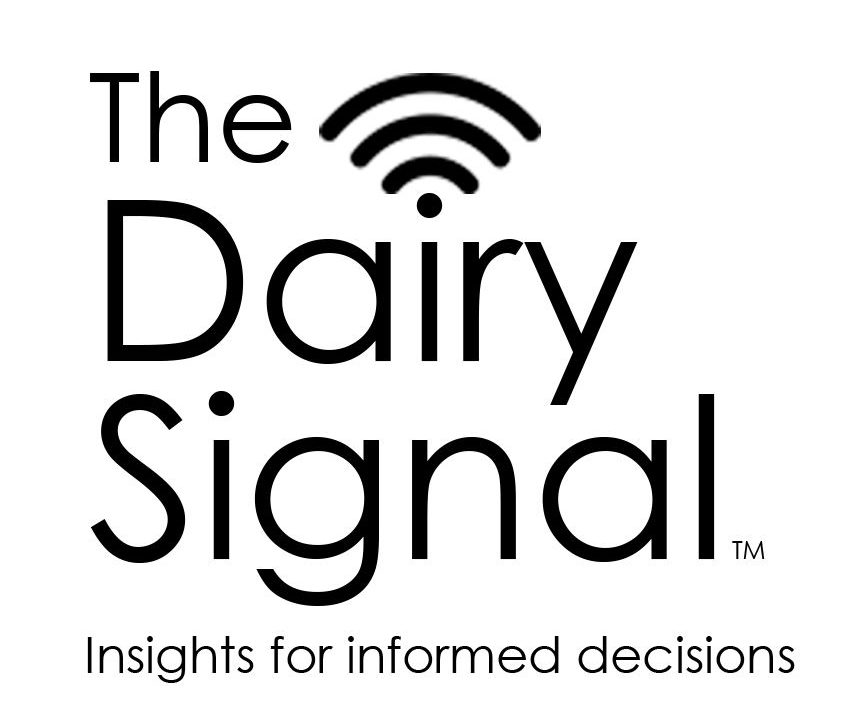
Professional Dairy Producers® (PDPW), announces the line-up of speakers for week 75 of The Dairy Signal™. Episodes this week will provide timely insights on farm safety, raising heifers and dairy market news.
Cheryl Skjolaas, Senior Outreach Specialist with the University of Wisconsin Center for Agricultural Safety and Health, and Justin Wege, Ag Mechanics Instructor/Tractor Safety Program Lead, Department Chair for Ag Mechanics, Outdoor Power Equipment, and Farm Business Production Management, Fox Valley Technical College, will provide important information on farm safety as we move into fall harvest season and recognize National Farm Safety and Health Week Sept. 19-25.
Walt Moore, President/Owner, Walmoore Holsteins, Inc. and Moocha Milk Transportation, Inc., West Grove, Pennsylvania, Tony Brubaker, Partner, Brubaker Farms, Mount Joy, Pennsylvania and Amanda Arata, General Manager, Kansas Dairy Development, Deerfield, Kansas, will lead a panel discussion on decision factors involved in raising replacement heifers at home or at a custom operation.
Dan Basse, Economist and President of AgResource Company, will return for a regular update on dairy markets and news.
Developed by fellow dairy farmers from the PDPW Board of Directors, The Dairy Signal is a weekly series of free educational episodes offering insights and resources for fellow dairy farmers and other food system professionals throughout the value chain. The episodes air live from 12:00-1:00 PM CT each Tuesday, Wednesday, and Thursday; recorded sessions are available later in the day.
Researchers Predict Future Forest Loss
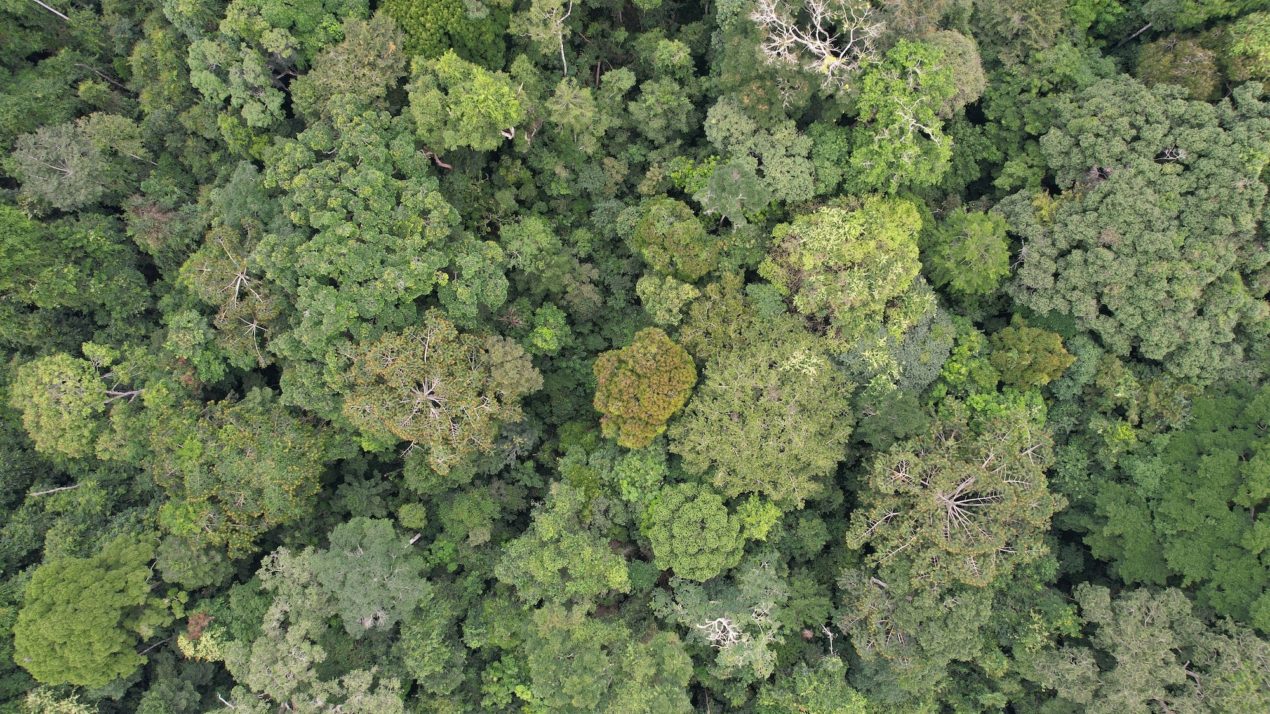
Protected forests are unlikely to be cut down when they are surrounded by intact forests, according to findings from a new analysis of protected forests worldwide.
Conversely, the more degraded the boundaries of a protected area are, the more likely that deforestation will encroach into the protected forest as well.
These findings have the potential to help national governments and other agencies direct limited resources toward those areas at greatest risk of deforestation, which threatens biodiversity and releases large amounts of carbon dioxide into the atmosphere.
“We wanted to find out what happens to the forests in protected areas when there is less and less forest around them — when their buffer zone starts getting less dense and more like a mosaic of forest and fields,” says Zuzana Buřivalová, lead author of the new study and a professor of forest and wildlife ecology at UW-Madison. “Based on the percentage of forest cover around a national park, we can now predict and say: ‘Okay you should be careful right now’ or ‘You don’t have to worry just yet.’”
By using satellite imagery of every protected forest around the world — largely made up of national parks and forests — Buřivalová’s team analyzed the trends of forest loss both within those protected areas and in the territory extending 5 kilometers from the boundary. The researchers studied forest loss from 2000 to 2018 and made predictions for the next 18 years, to 2036.
They discovered that when more than 90 percent of the boundary zone remains forested, the protected area is likely to experience little or no deforestation. When the adjacent territory drops to about 20 percent forest cover, the protected area starts to lose forest cover at equal rates to the nearby region — as if it is no longer protected.
Although satellite imagery analysis alone cannot determine why nearby deforestation threatens protected forests, the researchers suspect that multiple factors contribute. Adjacent farms may run out of land and start expanding into the protected area, or new roads may make access to the national park easier, for example. In both scenarios, the nearby region would experience forest loss first.
The researchers have published detailed results and the code used to analyze the images so that government agencies charged with protecting the lands can make better predictions.
Based on current trends, the scientists predict that two-thirds of protected areas will experience little forest loss through 2036. However, any acceleration in average forest loss would greatly increase the number of protected forests at risk.
CALS Captures Back-To-School Moments
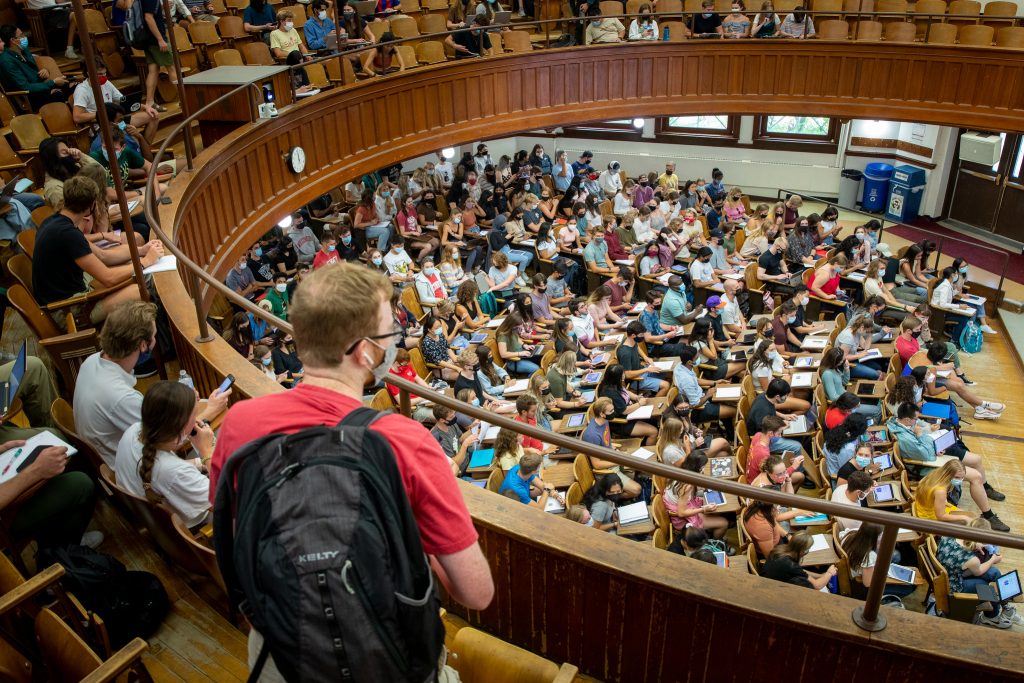
Students settle into their seats before the start of Biochem 501 (Introduction to Biochemistry) in the historic Agricultural Hall lecture hall on the first day of classes at UW–Madison Sept. 8, 2021. Photo by Michael P. King/UW–Madison CALS.
Last week, the UW-Madison College of Agricultural and Life Sciences began welcoming students to campus with orientation and other activities for new and returning students.
The first CALS undergraduate students to arrive on Aug. 29 were students in CALS QuickStart, a summer program designed to prepare incoming CALS freshman to succeed in college. Dorm move in for all UW-Madison students started Aug. 30.
The first day of classes was Sept. 8. More than 525 new undergraduates are expected to join CALS this fall.
The college captured photos of the events and back-to-school activities that took place as part of the university’s “Wisconsin Welcome” program.
Do you know a CALS student? Are you a CALS student? You can see the photos in a CALS Flickr album: https://www.flickr.com/photos/uwmadisoncals/albums/72157719809830557/
Time To Collect Milkweed Seeds
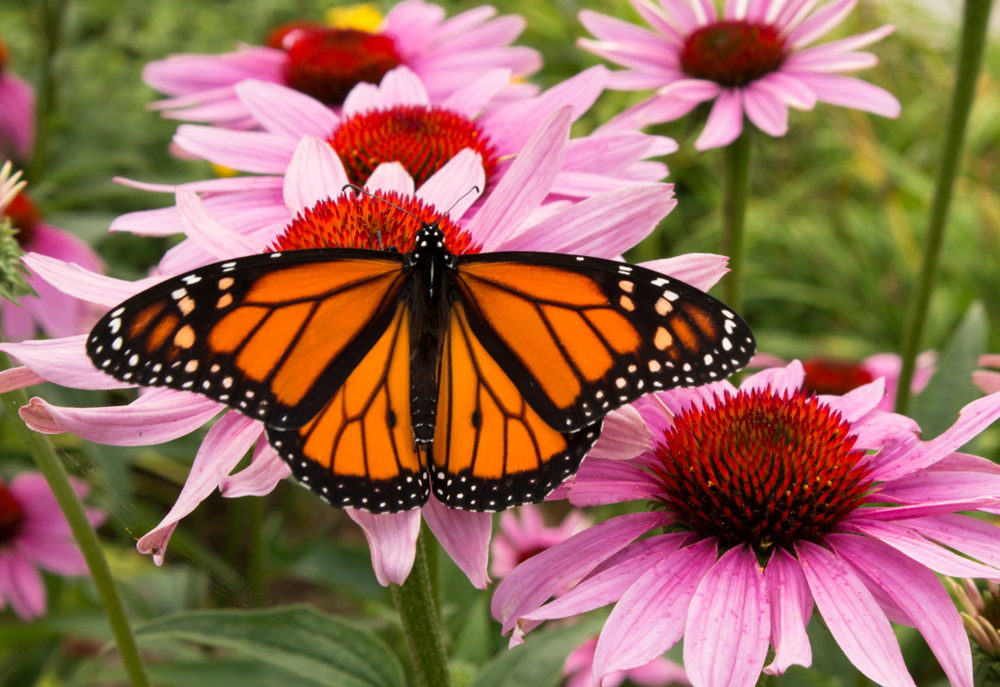
The DNR is asking nature lovers and landowners in Wood, Portage, Adams, Juneau, Waushara and Marquette counties to collect wild common milkweed seedpods this September to help grow habitat for native pollinators on state lands.
Volunteers are encouraged to harvest mature wild common milkweed seedpods from their property or neighbors’ fallow fields (with the property owner’s permission) through Sept. 30 and drop them off at DNR CWD sample collection sites in Adams, Necedah and Wisconsin Rapids.
The DNR will use collected seeds as part of a monarch habitat restoration project across several State Natural Areas in the Central Sands region.
See illustrated instructions for collecting and delivering the seedpods: https://widnr.widen.net/s/p5tt5hf7l7/milkweed-harvest-21_d2
Drop off sites:
- Adams County: Friendship Ranger Station, 532. N. Main St., Adams, WI
- Juneau County: Necedah Ranger Station, 400 Birch St., Necedah, WI
- Wood County: DNR Wisconsin Rapids Service Center, 473 Griffith Ave., Wisconsin Rapids, WI
Efforts help monarchs and other pollinators vital for sustaining Wisconsin’s native ecosystems, many food crops and the treasured sight of monarchs flying in summer skies.
Federal Energy Grants Benefit Rural Wisconsin

The USDA is investing $464 million to build or improve renewable energy infrastructure in 48 states, including Wisconsin.
The decision, announced by Wisconsin Rural Development Acting State Director Michelle Wallace, aims to help rural communities, ag producers and businesses lower energy costs.
“When we invest in infrastructure to lower energy costs, we build opportunity and prosperity in our rural Wisconsin communities,” says Wallace. “These investments support the local economy by making our communities attractive, economically viable and safe places to live and work.”
The investment will conserve and generate more than 379 million kilowatt-hours in rural America, or enough electricity to power 35,677 homes per year.
In Wisconsin:
- Lost Creek Adventures LLC, a full service paddling outfitter operating within the Apostle Islands National Lakeshore, will use a $5,100 grant to install a 6.66 kilowatt solar electric system. This project will save $1,025 per year and replace 8,720 kilowatt hours (66 percent) of the company’s energy use per year.
- Heather Secrist (Suncrest Gardens), a pizza farm serving local foods in Cochrane, will use a $20,000 grant to install a 36-kilowatt solar array. This project will save $5,520 per year and replace 50,427 kilowatt hours (95 percent) of the farm’s energy use per year, which is enough energy to power four homes.
- Fitchburg Farms LLC, a full-scale garden center providing an array annuals, perennials and other garden materials, will use a $4,200 grant to install energy efficient greenhouse components. This project will save $6,769 per year and replace 246,495 kilowatt hours (37 percent) of the business’s energy use per year, which is enough energy to power 22 homes.
- Mechanical Research & Design Inc, a design and fabrication business in Manitowoc, will use a $10,200 grant to install LED lighting and sensors throughout their warehouse, storage and administration areas. This project will save $5,125 per year and replace 48,355 kilowatt hours (65 percent) per year, which is enough electricity to power four homes.
- J.W. Speaker Corp, a vehicle lighting manufacturer in Germantown, will use a $20,000 grant to install energy-efficient lighting systems. This project is expected to save $12,471 per year and will replace 207,863 kilowatt hours (44 percent) of the company’s energy use per year, which is enough energy to power 19 homes.
- Uptown Motorcars Inc, a car dealership in Slinger, will use a $13,200 grant to install a 20 kilowatt solar array. This investment will save $2,296 per year and will replace 26,264 kilowatt hours (120 percent) per year, which is enough electricity to power two homes.
- Nordik Meats Inc, a meat processor in Viroqua, will use a $20,000 grant to install a 120 kilowatt solar system. The system is estimated to generate 167,280 kilowatt hours per year, which is enough electricity to power 15 homes.
- Thomas E. Kuchta, a grain farmer in Peshtigo, will use a $15,700 grant to install a grain dryer. This project will save the farm $8,767 per year and replace 163,058 kilowatt hours (89 percent) per year, which is enough electricity to power six homes.
- Jolma Electric LLC, an electrical contractor in Ashland, will use a $6,300 grant to install a 19.24 kilowatt solar array. This project will save $2,644 per year and replace 24,032 kilowatt hours (99 percent) per year which is enough electricity to power two homes.
- Michael I. Mikrot, a beef rancher in South Range, will use a $7,400 grant to install a 10.3 kilowatt solar array. This project will save $2,111 per year and replace 14,793 kilowatt hours (106 percent) of the farm’s energy use of electricity per year.
- Joseph L. Zenz, a grain farmer in Lancaster, will use a $14,900 grant to install an energy efficient grain dryer. This project will save $7,717 per year and save 22,985 kilowatt hours (14.5 percent) of the farms energy use per year, which is enough to power two homes.
- Friese Properties LLC, a nonresidential building lessor in Hudson, will use a $5,900 grant to install a 6 kilowatt solar electric array. This project is expected to save $519 per year and will replace 8,655 kilowatt hours of electricity per year.
- Ronald Rundhaug, a dairy farmer in Dodgeville, will use a $6,700 grant to install a 19.2 kilowatt solar electric system. This project will save $1,930 per year and replace 25,904 kilowatt hours (155 percent) of the farm’s energy use per year.
- RNR Farms LLC, a grain farm in Glen Haven, will use a $19,100 grant to install a grain dryer. This project will save the farm $9,945 per year and replace 300,818 kilowatt hours (51 percent) per year, which is enough electricity to power 27 homes.
Corn Yield Forecast Up
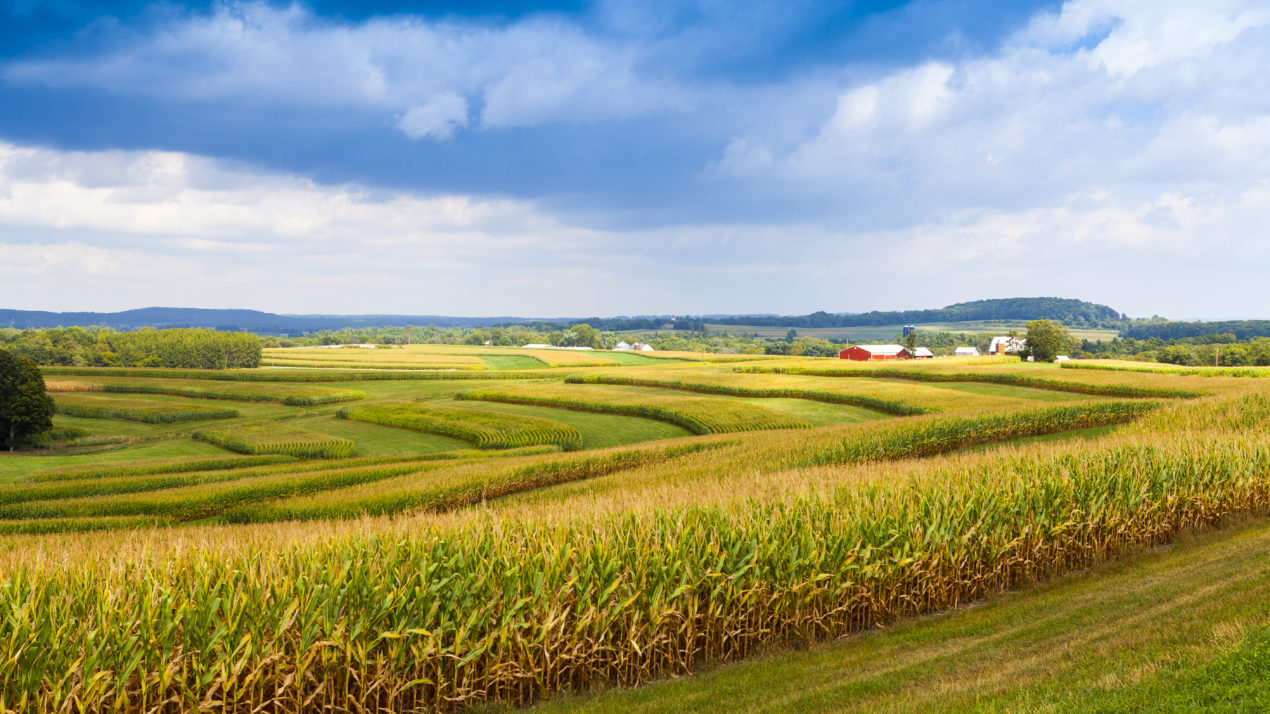
Wisconsin corn production is forecast at 506 million bushels according to the latest USDA, National Agricultural Statistics Service – Crop Production report.
Based on conditions as of Sept. 1, yields are expected to average 172 bushels per acre, an increase of 5 bushels per acre from the Aug. 1 forecast but down 2 bushels per acre from last year.
Corn planted acreage is estimated at 3.95 million acres. An estimated 2.94 million acres will be harvested for grain. Acreage updates were made based on a thorough review of all available data.
Soybean production is forecast at 101 million bushels. The yield is forecast at 49.0 bushels per acre, unchanged from the Aug. 1 forecast but 2 bushels below 2020.
Soybean planted acreage is estimated at 2.1 million acres with 2.07 million acres to be harvested. Acreage updates were made based on a thorough review of all available data.
The forecasts are based on Sept. 1 conditions and do not reflect weather effects since that time. The next crop production forecasts, based on conditions as of Oct. 1, will be released on Oct. 12.

